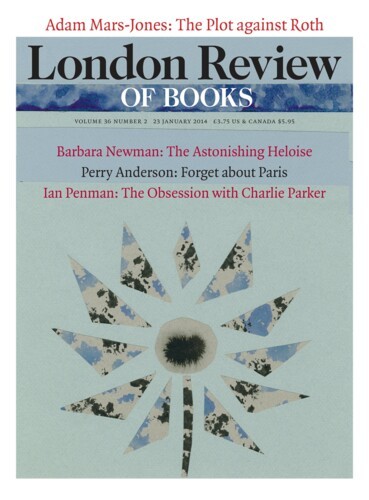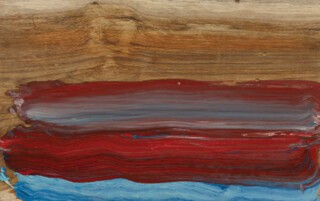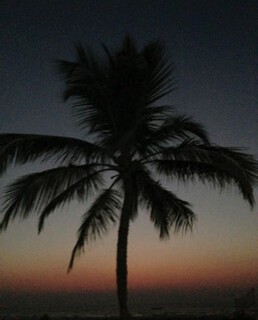Howard Hodgkin has finished a new painting. It is called Summer Rain, and is painted with oils on a framed wooden panel, about two metres in length and just over one metre high. At the centre a pinkish-brown form like a cool fireball rises vividly against a background of luxuriant green – foliage perhaps, or even palm trees, which appear often in Hodgkin’s pictures. A band of dirty yellow, blending into dark brown and sap green, frames the scene. Emerging from behind the fireball is a bright cadmium red tongue. It holds centre-stage and seems at first to be the subject of the painting, rather than the summer rain of the title. But then something about the cool warmth, the saturated colours, a feeling of physical deliciousness, of palpable relief, brings the subject back.
Summer Rain is one of a group of new paintings to be shown later this year at the Gagosian in Paris. Hodgkin worked on some of them during a two-month stay in India last year. The largest and grandest (a word Hodgkin probably wouldn’t like) of these is Ganges, a mostly green painting made on a plain wooden panel mounted in an antique picture frame. Hodgkin buys old frames and has them made up as supports; often he turns them round and paints on the back. Ganges is painted on the front. At the centre is an area of diaphanous grey, seen through a light green opening into which has been wedged a grey and black form, like a shuddering door. The framing strokes are thick and lush, the paint mixing down to a sombre green and red soup. Hodgkin has never seen the Ganges, he told me recently; he imagines it as very dirty but very beautiful. ‘You can’t see the bottom,’ he added, perhaps recalling a passage from Eric Newby’s Slowly down the Ganges, a book he knows well. Hodgkin’s paintings are never literal illustrations of his titles, even his early portraits. The point is not to get to the bottom, but to stay immersed.
When I saw it, Ganges was hanging across from Summer Rain in Hodgkin’s London studio. In Mumbai, Hodgkin has a studio in his hotel. He has another studio in the grounds of his house in Normandy. Paintings are often started in one place and finished elsewhere. The ‘elsewhere’ is an important part of the painting process. Because some of them take years to complete, this is a matter of necessity; time is also a medium for Hodgkin, through the processes of deliberation and detachment.
Next to Summer Rain in the London studio hangs a much smaller, more enigmatic painting called The Sea, Goa. Measuring barely a foot across, it seems at first glance to consist of nothing more than three horizontal stripes of scarlet red and cobalt blue, stacked at the bottom of the panel, in landscape orientation. The horizontal grain of the wood showing in the top half of the panel, which seems to have been left bare, matches the striations in the brushmarks below. The grain wells around a knot, which suddenly makes sense of the image as a seascape with a setting sun.
The picture recalls an experience, someone close to Hodgkin told me, of sitting last year on a terrace looking out onto the beach at Goa as the sun set. As the light faded, paragliders on the foreshore were silhouetted against the sky; beach-ball games continued in the half-light; a policeman shot a gun to scare some crows. None of this can be seen in the painting: it is at first barely readable as a seascape, and does not hide that it is a painted piece of wood. Hodgkin rarely, if ever, discusses the back stories to his works – he doesn’t like to show the bottom of the river. Hearing a rare first-hand account of the moment from which a painting sprang was fascinating. There is even a photograph to compare with the painting. A palm tree, the dark beach, the heavy haze of a hot Indian evening. Looking at this photograph, even displayed on the tiny screen of a mobile phone, I felt that Hodgkin had captured the atmosphere of the beach at dusk: the dirty quality of light, the hazy frayed edges of sand and sea, sea and sky. It stops you in your tracks to see the precision and economy with which the experience has been translated into a combination of coloured pigments, suspended in oil, brushed in three gestures onto an old piece of wood.
Like many of Hodgkin’s works The Sea, Goa is a relic of a moment. It is painted, I was told, on a small piece of wood found in an antiques shop in a godown in the suburbs of Mumbai. One side (now the back of the painting) had a shallow depression, used perhaps for crushing spices. Back in London, before Hodgkin began the painting, the wood was split along its length (like cutting a pack of cards), revealing a fresh surface ready, as if it had been waiting for many years, for the memory to be cast upon it.
Send Letters To:
The Editor
London Review of Books,
28 Little Russell Street
London, WC1A 2HN
letters@lrb.co.uk
Please include name, address, and a telephone number.



